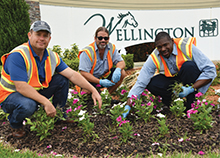Wellington’s Landscaping Team Works To Keep The Community Green Going Native
One key to Wellington’s allure, both to residents and visitors, is its small-town feel. An important part of that atmosphere is the amount of green space and trees found in the community. Wellington’s landscaping team is key to setting the tone, from the moment one drives past the first Village of Wellington welcome sign.
Brian Hopper is the operations superintendent in charge of all landscaping and trees found on village property. Over the past seven years, he has taken his master’s degree in forest resources and conservation from the University of Florida to bring the vegetation in Wellington to a more natural state.
“Having a strong natural resources background gives me the tendency to use native species whenever I can. I’m always looking for ways to increase our tree canopy,” Hopper said. “My favorite thing is when I get an opportunity to be creative. By that I mean, do our own in-house designs for landscape enhancements, especially to plant trees in spaces that didn’t have any.”
This tendency to use native plants has long-term side effects for Wellington that are beyond just aesthetics.
“Native plants are more cost effective,” said Deputy Director of Public Works Bill Conerly, who is Hopper’s supervisor. “They require less treatment, too. You don’t get the exotic pests, and they don’t need the herbicides to take care of themselves. I’m a Florida guy. I’ve seen the changes, and the native species are low maintenance compared to exotic plants.”
Conerly and Hopper have worked together for years and share a passion for taking care of Wellington’s greenery. One such project they are both proud of is the Wellington Environmental Preserve at the Marjory Stoneman Douglas Everglades Habitat, located at 3491 Flying Cow Ranch Road.
“It started off as an old agricultural field that was nothing but Brazilian pepper, and they carved out the retention areas to attract birds,” Hopper recalled. “They did initial plantings, and we have added to it every single year just to make it better. Now, everything has started to grow and recruit native species. Not only do you get to see aquatic vegetation but upland habitats — all built from scratch.”
The 365-acre preserve has been a work in progress that began in 2007 and now has plants ranging from wildflowers to oak trees re-seeding and growing on their own. Originally designed to be a stormwater retention area, there is much more going on at the preserve now. “It’s amazing all the native species that you can see at any given time,” Conerly said. “We have migratory birds, bald eagles and ospreys. We put out osprey perches, and you can see them eating fish and interacting with each other.”
Hard work and consistency have paid off. Wellington has been awarded a Tree City USA designation for more than 20 years running. In addition, the village has also maintained a growth award for the past 10 years, proving there is an increased level of attention and commitment to the trees here.
“For the past five years, we have planted an average of approximately 500 trees a year, and about 1,500 seedlings each year at the Wellington Environmental Preserve,” Hopper said. “We also give away free seedlings to all the local schools in celebration of Earth Day, and we offer free trees at the Earth Day event held at the Wellington Amphitheater.”
For Hopper, the big projects are great, but he feels it is the little projects that add up to big things.
“We have high-profile projects — like the landscape berm over near Stribling Way and State Road 7 — but it’s the amalgamation of all the tiny little projects that make a difference,” he said. “It’s the small neighborhood entryways, like the median in front of a neighborhood that we overhauled even when no one asked for it, and it looks so much better. They may not be projects that cost hundreds of thousands of dollars, but I know it has an effect on people’s daily lives.”
One example is an upcoming planting project to add more trees along pathways in the preserve to create better shaded stopping points for trail users. In the end, the purpose always comes back to the community and its residents.
“When you have a resident write on social media about how great something looks — when the public says that, it really makes you feel good,” Conerly said. “One good compliment goes a long way.”
Hopper and Conerly view their work in Wellington as more than just a day job. “I always like to say if you do what you love for a living, sometimes it doesn’t feel like work,” Hopper explained. “It’s nice to be able to enjoy what you do when you have a passion for it.”
He also shared a little advice for locals when deciding what to plant in their own spaces. “Stay away from the plants that you know are pest problems, or plants that you know are going to have to be treated,” Hopper said.
Conerly couldn’t agree more. “In my personal yard, if it doesn’t attract a butterfly, a bee or a bird, I try not to plant it,” he said.
